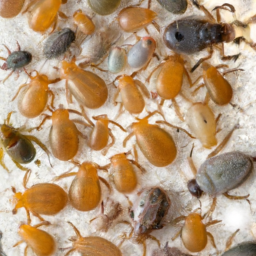Mites vs Bed Bugs: Understanding the Difference
Mites and bed bugs are two small, parasitic organisms that can cause itchiness and discomfort. Recognizing the differences between them is essential to identifying the infestation and treating it correctly.
What Are Mites?
Mites are tiny, eight-legged creatures that are related to spiders and ticks. They feed on animals and plants, and hundreds of species live outdoors in soil, fresh and saltwater, and on decaying plants and animals.
What Are Bed Bugs?
Bed bugs are parasitic insects that feed on blood from warm-blooded animals. They can survive in an array of habitats but are most commonly found in mattresses and other pieces of furniture in human habitations.
What Are the Differences Between Mites and Bed Bugs?
-
- Size: Mites are usually smaller than bed bugs.
-
- Life Cycle: Mites live for weeks or months, while bed bugs can live up to one year.
-
- Feeding: Mites feed on plants and small animals, while bed bugs feed on the blood of warm-blooded animals like humans.
-
- Habitats: Mites live outdoors and in animals, while bed bugs typically inhabit mattresses and other furniture.
Although mites and bed bugs are both small parasitic organisms, they are very different in terms of size, life cycle, feeding habits, and habitats. It is important to identify the infestation in order to treat it efficiently. Knowing the signs and symptoms of an infestation, such as itchy bites, can help you better identify what type of bug you are dealing with.
Many people might mistakenly believe that bed bugs and mites are the same types of pests. However, while they have some similarities, these two creatures are very different.
Mites are arachnids, but they are quite small and hard to see, even when you look closely. They have a simple body structure, with four pairs of legs, and are generally around 1/3 the length of a millimetre. They can survive without food for many months and feed on a variety of organic materials, including dead skin and hair or seed, plant or insect remains.
Bed bugs, on the other hand, are larger, much more visible and easily distinguishable from mites. They are typically around 5 millimetres long and have six legs and a much harder body structure than mites. Bedbugs will feed on human blood, and they are known to easily spread through travel and humans transporting them on their clothing.
One of the biggest differences between the two pests is the speed at which they reproduce. Mites reproduce quickly, and females can lay several eggs at a time, often hundreds in their lifetime. Bed bugs are much slower, with females only laying one to five eggs alternatively.
Mites and bed bugs both have their unique set of qualities and behaviours, but one thing that both have in common is the fact that they can be a nuisance to humans. Mites can cause various skin irritations, while bed bugs can cause extreme itching and an array of health issues. As such, it is important to know the differences between the two and get professional help as soon as one has detected them.
Also Read: Chiggers vs Scabies
Related: 15 home remedies for bed bugs
Related: Earwig vs Silverfish
Related: Cat Fleas on Humans
Related: Chiggers
Related: Lice

